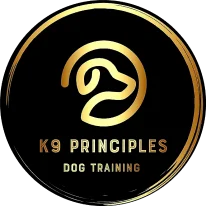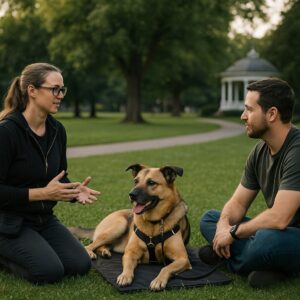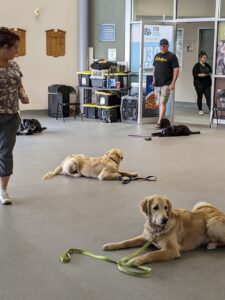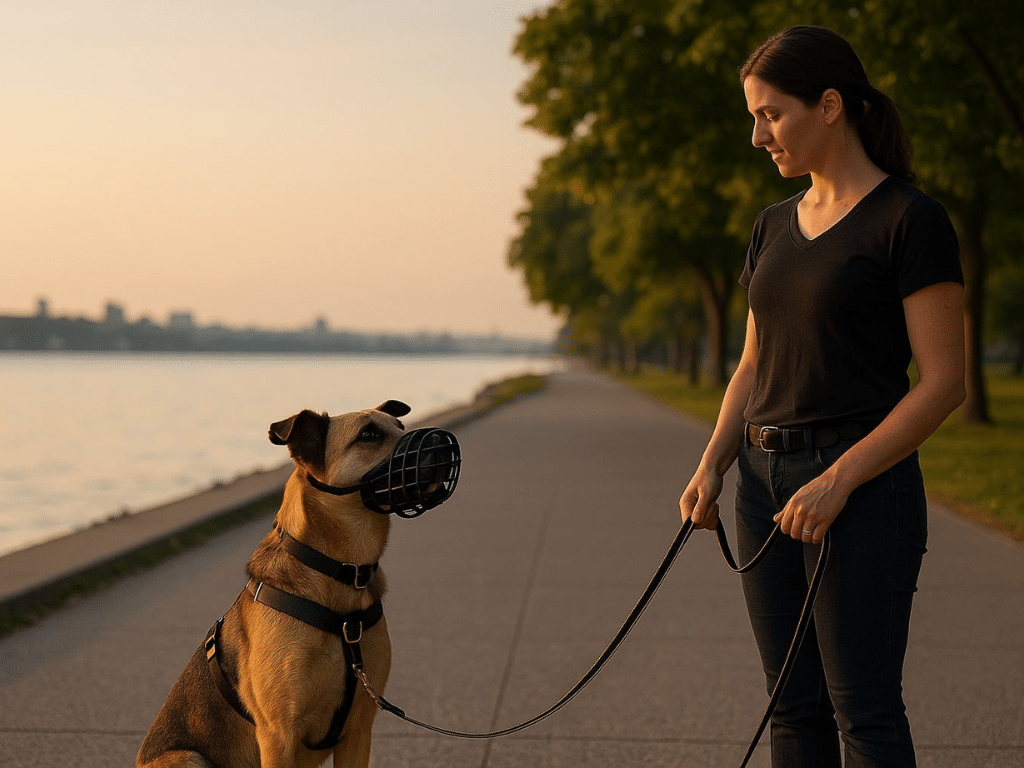Dog training in Hamilton is not just about teaching a sit here and a down there. It’s about keeping your home calm, your walks safe, and your dog’s stress genuinely lower so your life together feels easy and enjoyable. If you’re brand new to all this, you’re in the right place. Aggression can feel frightening, but it makes much more sense when we translate what your dog is trying to say. Once we understand the message, we can change the story. At K9 Principles, we work with first-time owners every day, and our approach is friendly, clear, and grounded in evidence with a deep respect for the dog in front of us. You’ll see why dog training based on cues, not fear, builds real reliability. You’ll also see how Hamilton dog training in real environments helps behaviours transfer from your living room to busy pavements and parks. By the end, you’ll know what aggression is, why it happens, the most common types, how to start rehabilitating safely without becoming an amateur behaviour scientist, and what practices make aggression worse so you can avoid them from day one.
Understanding Aggression Without Panic
Aggression is behaviour, not a personality label. It’s a set of actions that a dog uses when they feel threatened, overwhelmed, or that a vital resource may be taken away. Think of it as a protective umbrella rather than a single raindrop. The umbrella opens when the dog’s internal weather shifts: fear, pain, or frustration rises, options feel narrow, and the clearest path to safety seems to be driving the trigger away. When we treat aggression as communication, the fear softens on both sides. We stop asking, “Why is my dog bad?” and start asking, “What is my dog trying to protect, and how can we help them feel safe enough to choose something different?” That is the heart of ethical dog training and the glue of great results in dog training in Hamilton sessions that generalise to real life. When we show you how to work below your dog’s threshold with clean, timely reinforcement and generous clarity, the problem stops looking like a crisis and starts looking like a conversation you can actually guide.
The Difference Between Aggression, Reactivity, and Arousal
It helps to separate similar-looking behaviours so you don’t chase the wrong solution. Reactivity is often fast, loud, and showy: barking, lunging, spinning, or hitting the end of the lead. It’s heavily influenced by arousal and space; the dog wants the thing to move away or wants to reach it and can’t. Aggression can include those same displays but adds intent to increase distance or to keep a resource. Arousal is simply the volume knob of the nervous system; when it’s turned up high, small triggers sound like fireworks. In early Hamilton dog training sessions, we show you how body language, breathing patterns, ear and tail sets, and even weight shifts tell you whether you’re seeing fear, frustration, or escalating defence. Once you can read those signals, your timing improves, your cues land, and your dog finds it easier to pick the right response because you’ve finally made the right option obvious.
Why Aggression Happens: Pain, Genetics, Learning, and Environment
There are four pillars that we assess right away. First is medical status. Pain is one of the most common and most overlooked drivers of aggressive behaviour. Arthritic hips, dental issues, chronic skin irritation, or gastrointestinal discomfort can turn a simple touch into a perceived threat. When pain is present, dog training alone won’t fix it; we coordinate with your vet because relief opens the door to learning. Second is genetics and early development. Puppies who miss critical socialisation windows or experience frightening events can grow into dogs who find the world unpredictable. Third is learning history, which includes the behaviours that have been unintentionally rewarded over time. If barking at the door makes the delivery driver leave, the dog naturally repeats what worked. Fourth is environment: crowded sidewalks, narrow hallways, tension on the lead, and chaotic greetings make things harder. A smart plan modifies more than the dog. We modify the picture so the right choice is easier, safer, and more rewarding.
The Communication Ladder: From Whispered Warnings to Bites
Dogs rarely jump from calm to bite without leaving a breadcrumb trail. The ladder begins with tiny signals: blinking, lip licks, a slow head turn away, sniffing the ground for no obvious reason, or freezing for a heartbeat. If those whispers fail, the volume rises to hard stares, teeth showing, growls, snaps, and finally bites. We never punish the whisper. If you punish a growl, you lose an honest warning and drive the dog to skip steps. In dog training in Hamilton we teach you to observe the little indicators that tell you when to add space, when to cue a U-turn, and when to quietly ask for a attention to shift focus. The more you reward early communication, the less your dog feels trapped at the top rungs of the ladder.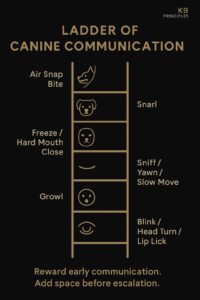
Trigger Stacking and Thresholds: Why Behaviour “Explodes”
Some days your dog seems fine; other days they react to a passing leaf. That’s trigger stacking. Stressors accumulate like pebbles in a bucket—poor sleep, a noisy neighbour, a rushed morning, a slippery floor at the vet—and the next tiny pebble spills everything over. Threshold is the point at which your dog can no longer think clearly enough to respond to your cue. We design Hamilton dog training plans that lower the daily load and keep sessions under threshold so learning actually sticks. You’ll learn to split challenges into smaller slices, to keep recovery windows generous, and to set the scene so your dog collects wins, not pebbles.
Types of Aggression You’ll Actually See at Home and on Walks
Fear-based aggression shows up when a dog perceives a threat and believes distance is the safest outcome. Defensive or protective aggression appears when the dog thinks a person, dog, or space needs guarding. Resource guarding involves food, toys, sleeping spots, or even people. Territorial aggression flares at doors, windows, or fences. Leash reactivity and barrier frustration are incredibly common; restricted movement increases tension, and proximity feels forced. Redirected aggression happens when the dog can’t access the trigger and bites whatever is closest. Handling-related aggression can surface with nails, grooming, vet exams, or being lifted suddenly. Finally, predatory behaviour is not rooted in fear; it’s a natural hunting sequence, and it needs careful, ethical management that prioritises safety in the community. We tailor dog training in Hamilton to the specific patterns we see, so you aren’t applying a fear protocol to a frustration problem or vice versa.
Safety First: Management, Muzzle Conditioning, and Ethical Equipment

Before you think about changing behaviour, lock in safety. Management simply means preventing rehearsals of the problem. We use baby gates, tethers, well-fitted front-attachment harnesses, and long lines to keep distance controllable outdoors. Muzzle training, done positively, is an act of kindness; it protects everyone and lets you relax to think clearly. A good muzzle is like a seatbelt. We condition it with choice and rewards so your dog actively puts their nose in, never as a forceful restraint. With beginners, we show how a lightweight long line paired with a consistently reinforced “let’s go” cue makes space creation effortless. This is practical, hands-on dog training that respects how dogs learn and how people actually live.
Vet Rule-Outs and Professional Help: How We Work at K9 Principles
When there’s a history of bites, escalating intensity, or sudden changes, we involve your vet early. Blood work and a musculoskeletal exam can be game-changers. As your trainers, we at K9 Principles build your practical plan, demonstrate the reps, and coach your timing so you can produce the same results when we’re not there. We put your goals first, we keep you safe, and we make the steps simple enough to do on a busy weekday. When you book dog training in Hamilton with us, you get a single integrated path: vet insights to rule out pain, a clear behaviour map, and small, repeatable home practices that build momentum.
Our Rehabilitation Framework: Calm Foundations, Choice, and Confidence
We start with calm because calm is the bridge to learning. You’ll learn a marker word that tells your dog, “Yes, that,” followed by a reward. You’ll use a settle-on-mat routine where your dog gets paid for breathing, blinking, and soft eye contact. We’ll teach a hand-target so your dog moves towards your hand for rewards, which doubles as a gentle steering wheel in busy places. We add choice at every step, because choice lowers threat. The dog can opt in and opt out; we reinforce engagement and we respect disengagement. In structured In-Home Private Hamilton dog training sessions, we introduce controlled versions of triggers at distances where your dog can still think. We pair those triggers with good things so the brain updates its predictions about the world. Bit by bit, the old fear story loses its grip and a calmer storyline takes hold.
Practical Protocols Without Jargon: Look-At-That, Engage/Disengage, Pattern Work
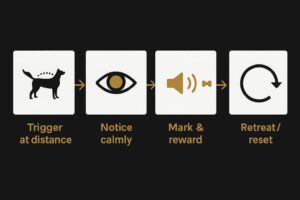
One of our favourites for beginners is Look-At-That. Your dog glances at the trigger, you mark, and you feed. The trigger becomes a cue for good news. Engage/Disengage adds a second loop: your dog looks, then looks back at you by choice, and that earns the pay. Pattern games build predictability—simple sequences like “we take two steps, you touch my hand, I feed; we repeat” give your dog a script when the world feels chaotic. None of this is complicated, but it is specific. In dog training, you want the right behaviour reinforced at the right moment, under the right threshold, so the dog’s brain saves the file. In dog training in Hamilton we practise these skills in quiet parks, wide sidewalks, and eventually livelier areas so the behaviours survive the real world.
Owner Skills That Accelerate Progress
The secret ingredient is you. Consistency, clean mechanics, and believable calmness are magnetic for your dog. Your timing improves when you watch the tiny tells—ear tips, whisker twitches, the breath before the bark. Your leash handling matters more than you think; soft hands prevent the micro-tugs that add static to the conversation. You’ll learn to ask with a cue, wait a beat, and then help if your dog is stuck rather than repeating yourself until the cue becomes background noise. You’ll refresh treats so the value stays high in tough moments. These are small, human-friendly skills that compound quickly, and we prioritise them in every Hamilton dog training session so you walk away feeling capable, not overwhelmed.
Methods That Make Things Worse (and Why We Never Use Them)
Punishing growls, alpha rolls, leash pops, and harsh corrections often suppress symptoms in the short term while inflating the fear that caused them. When the warning is punished, some dogs skip directly to a bite. Flooding—prolonged, forced exposure to a trigger—can make the dog shut down or explode. Harsh startle tactics create an unpredictable handler, which teaches the dog that the safest plan is to manage the human, not the environment. We refuse to build our results on fear. Ethical dog training rests on predictable cues, generous reinforcement for the right choices, and step sizes that your dog can genuinely handle. That’s how you get stable change rather than white-knuckle walking on eggshells.
Daily Life with a Dog Who Has Shown Aggression
Structure reduces anxiety. Predictable routines create a backdrop that tells the nervous system, “You’re safe.” Short decompression walks in quiet areas beat long chaotic routes through crowded streets, especially at the start. At home, we design simple visitor scripts that allocate space, use gates, and cue a mat settle while you manage doors and deliveries. If kids are part of your world, we lay out clear rules for interactions and demonstrate them until everyone feels fluent. When you book dog training in Hamilton with us, we don’t just teach exercises; we write the playbook for your actual Tuesday evening so it fits your house, your schedule, and your neighbourhood.
Measuring Progress Like a Pro—Even If You’re Brand New
You will feel better when you can see improvement in numbers, not just vibes. We show you how to note the distance at which your dog notices a trigger, how long it takes to recover to normal breathing after a surprise, and how often your dog offers a calm behaviour before being asked. Those measurements become your dashboard. As the weeks go by, triggers feel smaller, distances shrink, and recovery speeds up. That’s concrete proof that your dog training is landing. In structured Hamilton dog training sessions, we revisit your numbers and choose the next step based on data, not guesswork.
How Long Does It Take? Realistic Expectations and Sustainable Wins
Timeframes vary based on history, genetics, and lifestyle. Some dogs settle into their new routines within a few weeks; others need months of steady, kind practice. Progress is rarely linear. You’ll see spikes during weather changes, growth spurts, or after a vet visit. That’s normal. We plan for plateaus, we celebrate the quiet wins, and we keep the daily asks simple enough that you can maintain them on your busiest days. Sustainable dog training in Hamilton is about small, repeatable steps that become habits. When it’s easy to do, you’ll keep doing it, and your dog will keep improving.
Life in Hamilton: Real-World Setups, Parks, and Community Etiquette with Hamilton dog training
Local context matters. Wide-open spaces help with thresholds; quieter streets and off-peak times shrink the pressure. We choose training locations with clear escape routes, easy angles, and enough room to turn a corner gracefully. Community etiquette keeps everyone safe: space when passing, predictable paths, lead control near shopfronts, and friendly communication with other owners before dogs greet. We help you read the whole scene, not just your dog, so you feel composed and considerate. Good etiquette is not a rulebook; it’s a shared promise that your dog and your neighbours can count on. That community layer is where Hamilton dog training shines because we practise in the places you actually live.
K9 Principles × Hamilton/Burlington SPCA: Training That Gives Back
When you train with us through the HBSPCA, you help more than your own dog. Half of the registration fee supports the Hamilton/Burlington SPCA, funding vital animal-welfare work in our community. Training at the HBSPCA brings additional benefits: a friendly, well-equipped venue, exposure to a supportive environment, and easy access for Hamilton families. It’s one of the ways we ensure high-quality training is accessible and impactful. You can view current availability and sign up via HBSPCA Classes. Training that improves your household while supporting local rescue efforts is, quite simply, money well spent.
The payoff over time
In the first month, the house becomes calmer and walks become manageable. In three months, the outside world becomes predictable as your dog generalises the rules. At the six- to twelve-month mark—when you’ve maintained the routines—you enjoy a dog that responds first time in more places with less effort. Those gains don’t evaporate; they compound, because your dog’s default behaviour is now the behaviour you want.
If you’re ready to translate investment into results, give us a call today. We’ll recommend the shortest, smartest route from where you are to where you want to be, whether that’s a focused private package, a group pathway at the SPCA, or a blended plan that respects your budget and timeline.
Contact us for more information:
- Name: K9 Principles
- Address: Haldimand County, Greater Hamilton Area, Burlington, and Most of Norfolk County
- Phone: 289 880-3382
- Email: k9principlesinc@gmail.com
- Website: www.k9principles.ca
FAQs: Costs, Packages, Guarantees, and Results
-
A1. That depends on your goals and how rehearsed the current behaviour is, but we always design the shortest plan that can genuinely deliver transfer. Foundations for a friendly adolescent dog are often achieved over a focused block, while complex behaviours like reactivity or off-leash reliability require progressive proofing across environments. You’ll receive a realistic timeframe during your initial assessment so you know exactly what you’re investing in and when to expect each milestone.



